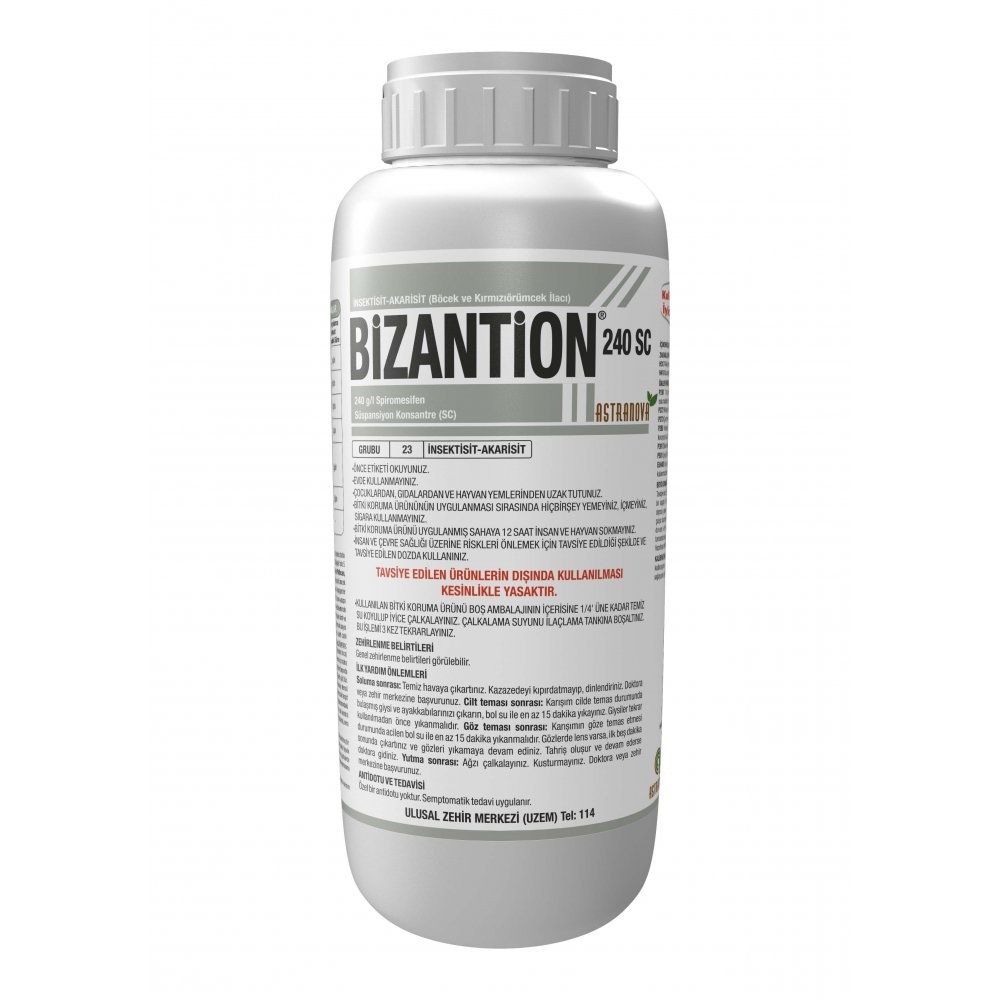BİZANTİON 240 SC

| Active Ingredient: 240 g/l Spiromesifen | |||||
| Formulation: Suspension Concentrate (SC) | |||||
| Packing: 200 ml, 250 ml, 300 ml, 500 ml ve 1 L | |||||
Use plant protection products with care.
Be sure to read the label and product information before use.
Label Information Safety Data Sheet Product Brochure| PLANT AND HARMFUL ORGANISMS THAT THE PLANT PROTECTION PRODUCT WILL BE USED FOR | |||||
| Plant Name | Harmful Organism Name | Application Dose | Between Last Application and Harvest | ||
| And Period | |||||
| Cotton | Two-point spider | 40 ml/da | 21 days | ||
| (Tetranychus urticae) | Egg, nymph, adult 21 days | ||||
| Cotton red beetle | |||||
| (Tetranychus cinnabarinus) | |||||
| Strawberry | Two-point spider | 50 ml/100 L water | 3 days | ||
| (Tetranychus urticae) | Nymph, adult | ||||
| Cotton red beetle | |||||
| (Tetranychus cinnabarinus) | |||||
| Eggplant | Two-point spider | 50 ml/da | 3 days | ||
| (Tetranychus urticae) | Nymph, adult | ||||
| Cotton red beetle | |||||
| (Tetranychus cinnabarinus) | |||||
| Watermelon | Two-point spider | 50 ml/da | 3 days | ||
| (Tetranychus urticae) | Nymph, adult | ||||
| Cotton red ladybug | |||||
| (Tetranychus cinnabarinus) | |||||
| Tomato | Two-point spider | 50 ml/100 L su | 3 days | ||
| (Tetranychus urticae) | Nymph, adult | ||||
| Cotton red ladybug | |||||
| (Tetranychus cinnabarinus) | |||||
| Tobacco whitefly | 60 ml/100 L water | ||||
| (Bemisia tabaci) | Larva, nymph | ||||
| Cucumber (Greenhouse) | Cotton red ladybug | 50 ml/100 L water | 3 days | ||
| (Tetranychus cinnabarinus) | Nymph, adult | ||||
| Carnation (Greenhouse) | Two-point spider | 50 ml/100 L water | - | ||
| (Tetranychus urticae) | Adult, larva, nymph | ||||
HOW TO USE THE PLANT PROTECTION PRODUCT Cotton - Red spiders: Controls are made when the plants have 4-6 leaves in order to determine the struggle time. If the pest is only locally located on the field edge or within, only these parts should be applied. Application should be made when an average of 5 live red spider mites are seen per leaf in the Mediterranean Region and 10 in the Aegean and Southeastern Anatolia Region. Eggplant, Tomato and Cucumber - Red spiders: Application should be made when an average of 3-5 live spider mites per leaf are seen in tomato, eggplant and cucumber. Tomato - Tobacco whitefly: Enter the area detected to be contaminated with whitefly in the direction of the diagonals. 50 leaves are collected from the lower, middle and upper leaves every five steps. Chemical control is applied when there are 5 larvae + pupa per leaf. Watermelon - Red spiders: For the first count in vegetable gardens, the diagonals of the parcels are crossed into the field during the flowering period. Every 3-5 steps, the red spider nymphs and adults are counted in the bottom and middle leaves of the plant. Live red spiders on the leaves are counted and recorded with a magnifying glass. The total number of red spider is divided by the number of leaves counted. There is a number of live red spiders per leaf. The fight is decided when an average of 5 live red spider mites are found per leaf.
Strawberry - Red Spiders: Early application: An application should be made when red spiders are seen in the flower and green fruit period (before the first ripe fruits appear) in the strawberry areas where the red spider is a problem every year. Early application is safer to prevent residue on fruits. In seasonal application: In cases where early period application is not made, strawberries grown in the open are checked at 3-5 day intervals at the beginning of the season (late March - early April). Red spiders can be seen on strawberries in the surrounding plants at the beginning of the season. First of all, it is sufficient to control and apply these plants. If the population is widespread, at least 50 leaflets are examined in the middle and lower parts of the plant to represent the field. If there are 15 or more red spider per leaflet, the application is decided. It is applied immediately after fruit collection. Harvest should be done by paying attention to the time between the last application and harvest. Carnation (Greenhouse) - Two-point red spider: Ornamental planting areas are frequently checked and especially red spider is sought under the leaves. When local contamination is detected, the pesticide struggle is only sprayed in these areas, greenhouses or open areas, when a common contamination is encountered.
MIXABILITY STATUS It can be mixed with many insecticides, fungicides and foliar fertilizers. It is recommended to make pre-mixture trials before mixing large amounts for application.